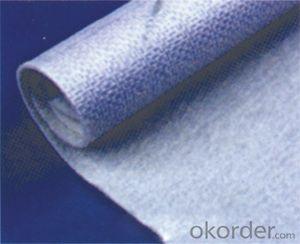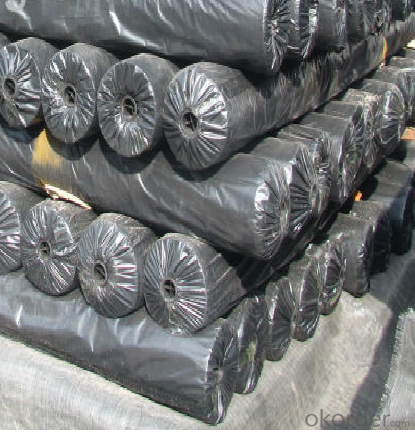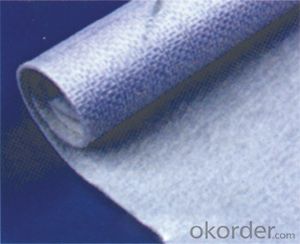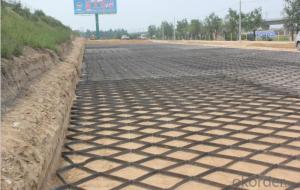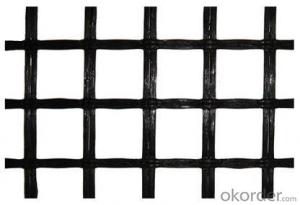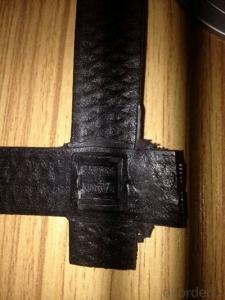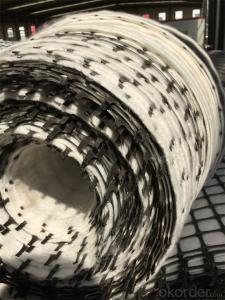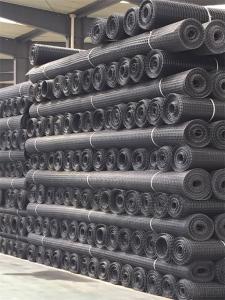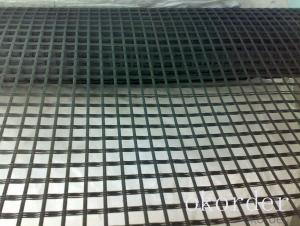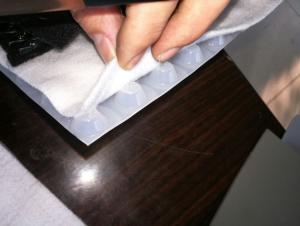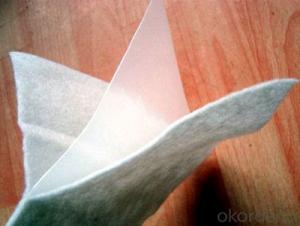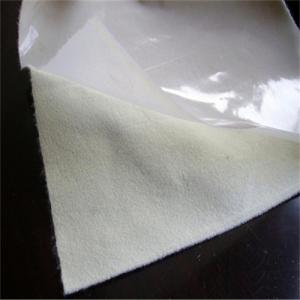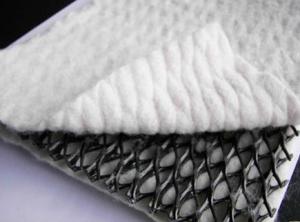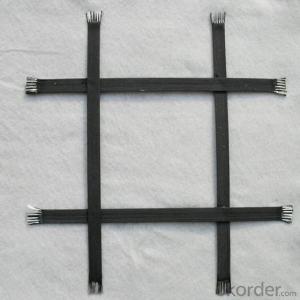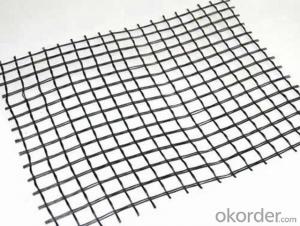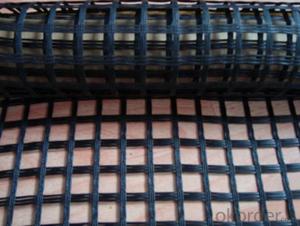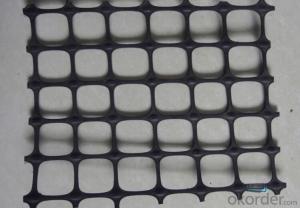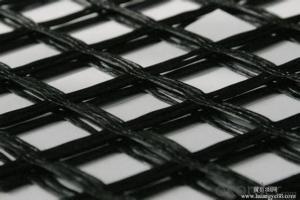Naue Geogrids Knitted Composite Geomembrane for Civil Construction
- Loading Port:
- Qingdao
- Payment Terms:
- TT OR LC
- Min Order Qty:
- 5000 m
- Supply Capability:
- 50000 m/month
OKorder Service Pledge
OKorder Financial Service
You Might Also Like
Specifications
High strength, anti-corrosion, tearing resistant and bursting resistant.
High strength polyester industrial yarns are adopted and, after treated with PVC laminating process, the geomembranes are abtained. These membranes prevent the permeation of water and change the defects of the current geomembranes with low strength and poor water resistance. As a result, they are widely used in such projects as the railroad foundation, dyke protective slopes, reservoirs, highway greenery belts, etc.
Application
Railroad foundations, tunnels, dykes, reservoirs, garbage filling fields, water-prevention and anti-permeation projects. Anti-seepage works of dyke. And application in anti-seepage works of water canal can save 80% of water.
Features
High strength, anti-corrosion, tearing resistant and bursting resistant.
Technical Parameters of Composite Geomembrane
Specification | PLGM-2020 | |
Performance | ||
Strength (kN/m) | Longitudinal | 20 |
Horizontal | 20 | |
Elogation | 30% | |
CBR strength (KN) | >2.5 | |
Thickness (mm) | >0.3 | |
Penetration coefficient (cm/s) | 10-11 | |
Width (m) | 2.5-3.5 | |
Length (m) | 30-50 | |
Functions
Ground stabilization
Drainage
Erosion control and re-vegetation
Revetment
Ground reinforcement
Asphalt underlayment
Road reinforcement
Features
1) Woven geotextile made on circle weave machine
2) Materials: polypropylene and other imported new materials
3) Weight per square meter: 80-700g/m²
4) Width: max. 6m
5) Perfect flexibility and against ultraviolet radiation and aging.
It can be widely used in areas of railways, highways, sport fields, earthwork projects, tunnels, coal mines, walls and slopes, environmental protection, and so on.
All colors and sizes can be customized.
Applications
1-Construction of roads and other trafficked areas (excluding railways and asphalt inclusion)
2-Construction of railways,
3-Earthworks, foundations and retaining structures,
4-Use in drainage systems,
5-Erosion control works (coastal protection, bank revetments),
6-Construction of reservoirs and dams,
7-Construction of canals,
8-Construction of tunnels and underground structures,
9-Use in solid waste disposals,
10-Use in liquid waste containment projects,
Woven Geotextiles Data Sheet
Item | Testing Method | Unit | ||
Grad Tensile Strength | ASTM-D 4632 | N | 890 | 1405 |
Grab Elongation | ASTM-D 4632 | % | ≤20 | ≤20 |
Puncture Strength | ASTM-D 4833 | N | 400 | 667 |
CBR Puncture | ASTM-D 6241 | N | 3200 | 4800 |
Mullen Burst | ASTM-D 3786 | kPA | 2578 | 4137 |
Trapezoidal Tear | ASTM-D 4533 | N | 500 | 750 |
Apparent Opening Size | ASTM-D 4751 | mm | 0.425 | 0.425 |
Permittivity | ASTM-D 4491 | Sec-1 | 0.05 | 0.05 |
Water Flow Rate | ASTM-D 4491 | 1/m/m2 | 163 | 163 |
UV Resistance | ASTM-D 4355 | % 500hrs | 70 | 70 |
Roll Width | m | 6 | 6 | |
Roll Length | m |
100 | 100 | |
Mass | GSM | 200 | 300
|
- Q: What is the main purpose of unidirectional plastic geogrid?Plastic geogrid production
- Unidirectional geogrid reinforced asphalt pavement or cement: Geogrid laying layer at the bottom of asphalt or cement, can reduce rutting depth, prolong the fatigue life of the pavement, but also can reduce the asphalt or cement pavement thickness, in order to save costs.For road slope and dam reinforcement and retaining wall: the traditional embankment especially filling high embankment filling and often need to shoulder edge easy compaction, resulting in slope rainwater invasion, collapse instability phenomena have occurred, but with a gentle slope, covers an area of large, the retaining wall has the same the problem of using geogrid embankment slope or retaining wall reinforcement can be reduced by two points a area, prolong service life, reduce the cost of 20 - 50%.
- Q: How do geogrids improve the stability of slopes?
- Geogrids improve the stability of slopes by providing reinforcement and preventing soil movement. They act as a barrier, distributing the forces exerted on the slope more evenly, reducing the risk of slope failure. Geogrids also increase the friction between soil layers, enhancing their shear strength and overall stability.
- Q: Can geogrids be used in reinforcement of underground structures?
- Yes, geogrids can be used in the reinforcement of underground structures. Geogrids are commonly used to provide additional strength and stability to soil layers, and they can be effectively utilized in underground construction projects to reinforce the surrounding soil and prevent potential collapses or deformations.
- Q: Geogrid price list geogrid products list geogrid manufacturers list
- Geotechnical grille on the material divided into fiberglass geogrid, steel plastic grille, plastic geogrid, polyester geogrid, used in different places for the pavement with the roadbed
- Q: How do geogrids improve the performance of geosynthetic filters?
- Geogrids improve the performance of geosynthetic filters by providing additional reinforcement and stability to the filter system. They enhance the tensile strength and load distribution capabilities of the filter, preventing soil erosion and maintaining the integrity of the filtration system. Additionally, geogrids help to reduce pore clogging and increase the overall longevity and efficiency of the geosynthetic filter.
- Q: Can geogrids be used in bridge abutment reinforcement?
- Yes, geogrids can be used in bridge abutment reinforcement. Geogrids are commonly used in civil engineering for soil stabilization and reinforcement. They can provide additional strength and stability to bridge abutments by improving the load-bearing capacity of the soil and preventing settlement or lateral movement.
- Q: How do geogrids help in preventing differential settlement?
- Geogrids help in preventing differential settlement by providing reinforcement to the soil, increasing its strength and stability. They distribute the loads more evenly, reducing the differential settlement by minimizing the differential movements between different sections of the soil.
- Q: What is the effect of installation spacing on geogrid behavior?
- The effect of installation spacing on geogrid behavior is that it can impact the overall performance and effectiveness of the geogrid. Proper installation spacing ensures proper load distribution and reinforcement, allowing the geogrid to effectively stabilize the soil and prevent deformation or failure. Inadequate spacing can lead to localized stress concentrations, reduced load capacity, and potential geogrid failure. Therefore, the spacing between geogrid installations is an important factor to consider in order to achieve optimal performance and long-term stability.
- Q: How do geogrids help in reducing the environmental impact of construction?
- Geogrids help in reducing the environmental impact of construction by providing soil stabilization and reinforcement, reducing the need for excessive excavation and material usage. This results in minimized disturbance to natural habitats, reduced waste generation, and lower carbon emissions, ultimately promoting sustainable construction practices.
- Q: What are the properties and characteristics of geogrids?
- Geogrids are synthetic materials made from polymers, typically high-density polyethylene (HDPE) or polyester, that possess a unique set of properties and characteristics. These include high tensile strength, low elongation, and excellent resistance to chemical degradation and biological attack. Geogrids also have a high modulus of elasticity, which allows them to distribute stress and improve the load-bearing capacity of soils and aggregates. They are typically lightweight and easy to handle, making them convenient for construction applications. Geogrids exhibit excellent dimensional stability and resistance to creep, ensuring their long-term effectiveness. They are also resistant to UV degradation and have a long design life. Overall, geogrids are versatile materials that provide reinforcement, stabilization, and confinement in various civil engineering projects, such as road construction, slope stabilization, and erosion control.
Send your message to us
Naue Geogrids Knitted Composite Geomembrane for Civil Construction
- Loading Port:
- Qingdao
- Payment Terms:
- TT OR LC
- Min Order Qty:
- 5000 m
- Supply Capability:
- 50000 m/month
OKorder Service Pledge
OKorder Financial Service
Similar products
Hot products
Hot Searches
Related keywords

